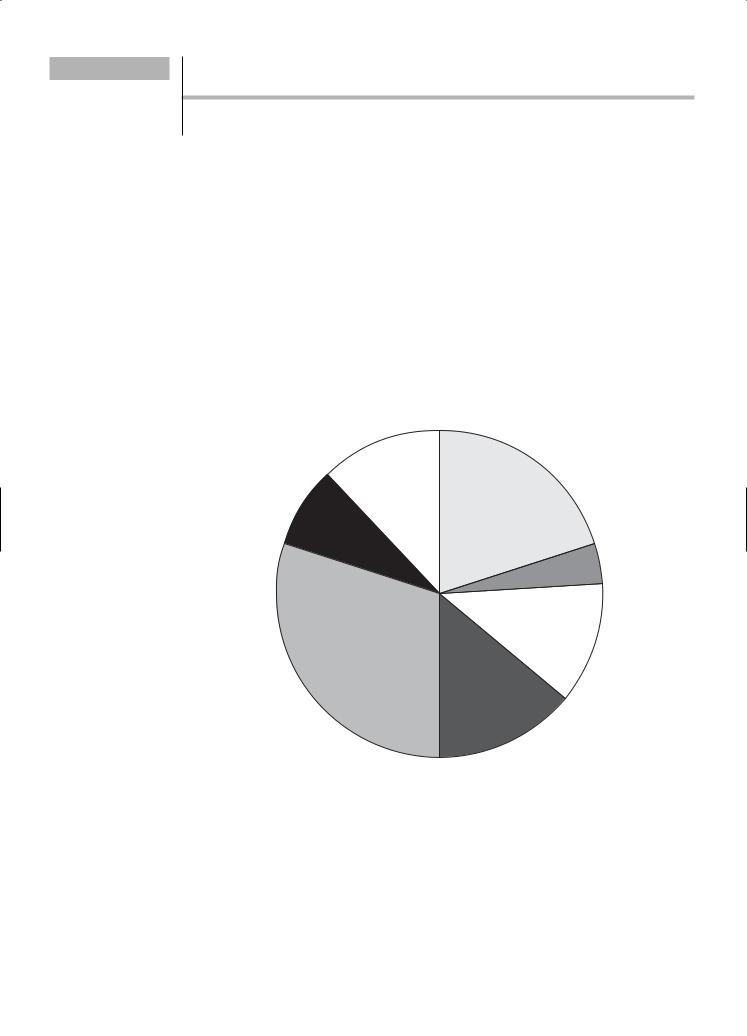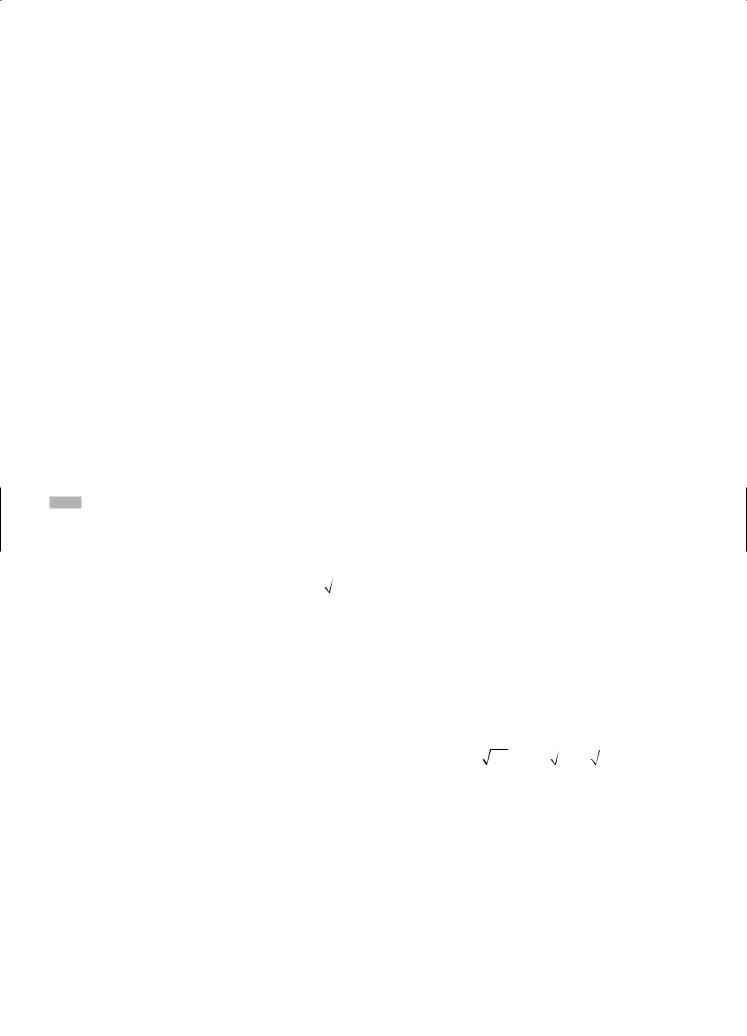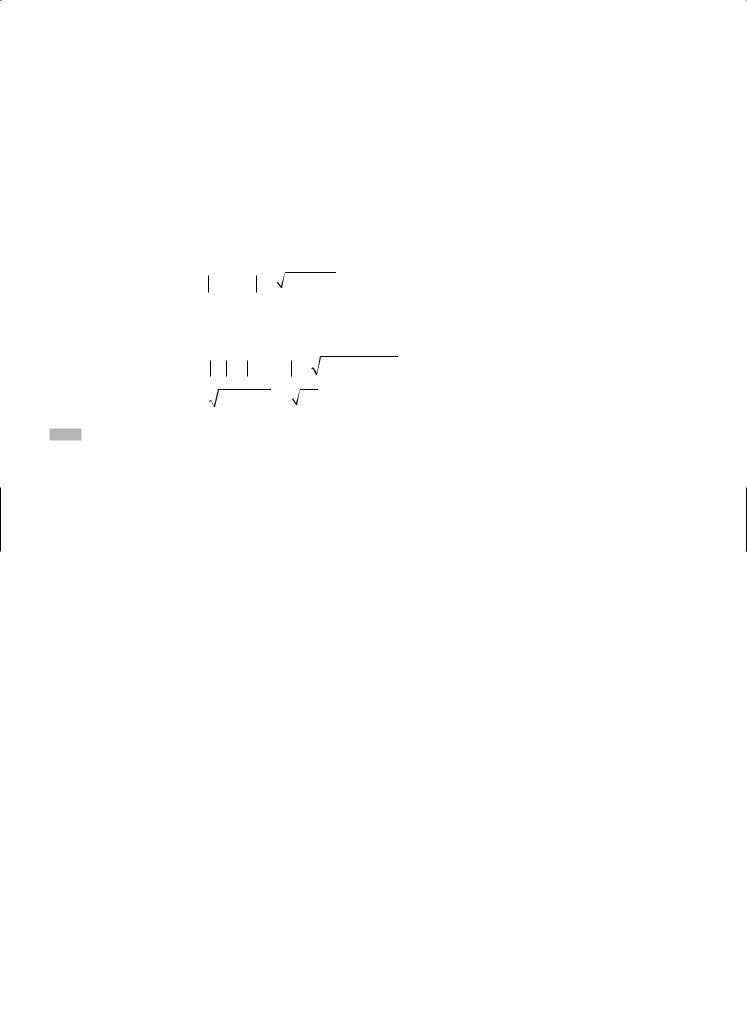
SAT 8
.pdf



CHAPTER 10 / NUMBERS AND OPERATIONS |
187 |
|||||
E X A M P L E : |
|
|||||
|
12 |
|
= |
8 |
. |
|
|
x + |
4 |
|
x |
|
|
12x = 8(x + 4). |
|
|||||
12x = 8x + 32. |
|
|||||
4x = 32. |
|
|
|
|||
x = 8. |
|
(Answer) |
|
|||
E X A M P L E :
If 0.3 cm3 of a substance weighs 5 grams, how many grams will 0.8 cm3 of the same substance weigh?
Let x = the weight of 0.8 cm3 of the substance. Then, set up a proportion to solve for x.
|
0.3 |
|
= |
0.8 |
. |
|
||
5 |
|
|
|
|||||
|
|
|
x |
|
||||
|
0.3x = 5(0.8). |
|
||||||
x = |
4 |
|
≈ 13.33 grams. |
(Answer) |
||||
0.3 |
||||||||
|
|
|
|
|
|
|||
COMPLEX NUMBERS
A complex number is a number in the form a + bi where both a and b are real numbers. The complex number system encompasses all of the real and imaginary numbers. a is the real part of a complex number, and bi is the imaginary
part. Recall that i = −1 .
Two complex numbers are equal when their real parts and imaginary parts are equal. For example, if 7 − i = a + bi, then a = 7 and b = −1.
Add complex numbers by adding their real parts and then adding their imaginary parts:
(a + bi) + (c + di) = (a + c) + (b + d)i.
(5 + 6i) + (−4 − 2i) = (5 + −4) + (6 + −2)i = 1 + 4i.
Multiply complex numbers by using the FOIL method as you would when
multiplying any two binomials. Because i = −1 , i2 = ( −1) ( −1) = −1. Once you use FOIL, remember to simplify the i2 term.
(a + bi)(c + di) = (ac − bd) + (ad + bc)i.
(5 + 6i)(−4 − 2i) = −20 − 10i − 24i − 12i2 = −20 − 34i − 12(−1) = −8 − 34i.
Similar to rationalizing the denominator of a radical expression by multiplying by the conjugate, the quotient of complex numbers is simplified by multiplying the numerator and denominator by the complex conjugate of the denominator. The complex numbers a + bi and a − bi are complex conjugates.
(a + bi)(a − bi) = a2 − abi + bai − b2i2 = a2 + b2.
(5 + 6i)(5 − 6i) = 25 − 30i + 30i − 36i2 = 25 + 36 = 61.

188 PART II / MATH REVIEW
E X A M P L E :
8 − i Simplify the quotient 5 + i .
Multiply the numerator and denominator by the conjugate of 5 + i, 5 − i.
|
8 − i |
× |
5 − i |
= |
|
|
40 − 8i − 5i + i2 |
|
|
|||||||||||||||
|
5 + i |
5 − i |
|
|
|
|
|
25 − i2 |
|
|
|
|
||||||||||||
|
|
|
|
|
|
|
|
|
|
|
|
|
|
|
||||||||||
= |
40 − 13i + (−1) |
|
|
|
|
|
|
|||||||||||||||||
|
|
|
|
|
25 − (−1) |
|
|
|
|
|
|
|
|
|
|
|
|
|
||||||
|
|
40 − 13i − 1 |
|
= |
|
|
39 − 13i |
. |
Now express the answer in the form a + bi. |
|||||||||||||||
|
|
|
|
25 + 1 |
|
|
|
|
|
|||||||||||||||
|
|
|
|
|
|
|
|
|
|
|
26 |
|
|
|
|
|
|
|||||||
|
39 |
− |
|
13 |
i = |
3 |
|
− |
1 |
i. |
|
|
|
|
|
|||||||||
26 |
26 |
2 |
|
2 |
|
|
|
|
|
|||||||||||||||
|
|
|
|
|
|
|
|
|
|
|
|
|
|
|||||||||||
E X A M P L E : |
|
|
|
|
|
|
|
|
|
|
|
|
|
|
|
|
||||||||
Simplify ( |
|
3 + |
|
|
− 6 )( |
3 − |
− 6 ). |
|
|
|||||||||||||||
Express the radicals in pure imaginary form first. |
− 6 = i 6 . Then, multiply |
|||||||||||||||||||||||
( 3 + − 6 )( 3 − − 6 ) = ( 3 + i 6 )( 3 − i 6 ) |
|
|||||||||||||||||||||||
= 3 ( |
3 ) − i 18 + i 18 − i2 (6). |
|
|
|||||||||||||||||||||
= 3 − (−1)(6) = 3 + 6 = 9. |
(Answer) |
|
|
|||||||||||||||||||||
Notice in the previous example that − 6 × − 6 ≠ |
36. When both radi- |
|||||||||||||||||||||||
|
|
|
|
cands are negative, you must express them as imaginary numbers and |
||||||||||||||||||||
|
|
|
|
then simplify. |
|
|
|
|
|
|||||||||||||||
In the example above, |
− 6 × |
|
− 6 became i |
6 × i |
6 = i2 36 = − 6. |
|||||||||||||||||||
Raising i to consecutive powers creates the following pattern: |
||||||||||||||||||||||||
|
|
i1 |
= i |
|
|
|
i5 |
|
= i |
|
|
|
|
|
||||||||||
|
|
i2 = −1 |
|
|
i6 |
|
= −1 |
|
|
|
|
|
||||||||||||
|
|
i3 = −i |
|
|
i7 |
|
= −i |
|
|
|
|
|
||||||||||||
|
i4 |
= 1 |
|
|
i8 |
= 1 |
|
|
|
|
|
|
||||||||||||
To determine the value of in, divide n by 4. A remainder of zero corresponds to i4 = 1. A remainder of 1 corresponds to i1 = i. A remainder of 2 corresponds to i2 = −1, and a remainder of 3 corresponds to i3 = −i. For example, i21 = i, since 21 ÷ 4 has a remainder of 1.
E X A M P L E :
Which of the following is equivalent to 1?
(A)i29
(B)i30
(C)i31

CHAPTER 10 / NUMBERS AND OPERATIONS |
189 |
(D)i32
(E)i33
in is equivalent to 1 when n is a factor of 4. Since 32 is divisible by 4, D is the correct answer choice. (Simplifying the other answers results in i29
= i1 = i, i30 = i2 = −1, i31 = i3 = −i, and i33 = i1 = i.)
You may be asked to find the absolute value of a complex number on the Level 2 test. Since the absolute value of any number is its distance from the origin, the absolute value of any complex number can be found by using the Pythagorean Theorem.
a + bi = a2 + b2
E X A M P L E :
If z = 3 − 4i, then what does z equal? z = 3 − 4i = (32 + (−4)2 )
(9 + 16) = 25 = 5. (Answer)
COUNTING PROBLEMS
The Fundamental Counting Principle states that if one action can be done in a ways, and for each of these a second action can be done in b ways, the number of ways the two actions can be done in order is a × b.
For example, if an automobile manufacturer produces 4 different models of cars and each one is available in 5 different colors, there are:
4 × 5 = 20.
20 different combinations of car model and color which can be created. Mutually exclusive events are events that cannot occur at the same time.
For example, when you roll a die, you either roll a 1, 2, 3, 4, 5, or 6. 1, 2, 3, 4, 5, and 6 are mutually exclusive events. When you flip a coin, you get either heads or tails. Heads and tails are also mutually exclusive. If the possibilities being counted are mutually exclusive, then the total number of possibilities is the sum of the number of possibilities in each group.
E X A M P L E :
How many positive integers between 0 and 100 can be created using the digits 1, 2, 3, 4, and 5?
Consider all the possible 1-digit and 2-digit integers that can be created using 1, 2, 3, 4, or 5. These are mutually exclusive events.
1-digit integers: |
5 possibilities for the ones digit |
2-digit integers |
(5 possibilities for the tens digit)(5 possibili- |
|
ties for the ones digit) |
Because the possibilities being counted are mutually exclusive, find the sum of the number of possibilities in each group.
5 + 5(5) = 30.
30 integers can be created. |
(Answer) |

190 |
PART II / MATH REVIEW |
E X A M P L E :
John’s high school offers 6 math courses, 4 English courses, and 3 science courses to students in his grade level. How many schedules are possible if John chooses a course in each subject?
Use the Fundamental Counting Principle to get: 6 × 4 × 3 = 72 schedules.
72 schedules. (Answer)
E X A M P L E :
In how many different ways can a 15-question true or false quiz be answered? Assume every question must be answered.
There are 15 “events” and each one has two possible outcomes. Using the Fundamental Counting Principle, you get:
2 × 2 × 2 × 2 × 2 × 2 × 2 × 2 × 2 × 2 × 2 × 2 × 2 × 2 × 2 = 215 = 32,768.
32,768 possible combinations of answers. |
(Answer) |
Now, try the previous example assuming that you can leave questions blank. The number of true/false questions doesn’t change, but now you have 3 possible outcomes for each question—true, false, or blank. The answer becomes 315 or 14,348,907 possible combinations.
E X A M P L E :
Rosemarie wears a uniform to work. As part of her uniform, she can wear one of 3 pairs of pants, one of 4 shirts, and one of two hats. How many pant-shirt-hat combinations are possible?
Again, use the Fundamental Counting Principle to get:
3 × 4 × 2 = 24
24 possible pant-shirt-hat combinations. |
(Answer) |
E X A M P L E :
A certain state makes license plates consisting of 6 symbols (letters and numbers), and it is a requirement that the letters always come before the numbers. How many license plates of 6 symbols (letters and numbers) can be made using at least one letter in each?
There are 6 mutually exclusive events possible—license plates with 1, 2, 3, 4, 5, or 6 letters. Recognize that there are 26 possibilities for choosing a letter and 10 possibilities for choosing a number (the digits 0 through 9) and it’s ok to use a number or letter more than once.
1 |
Letter and 5 Numbers: |
26 |
× 10 × 10 × 10 × 10 |
×10 = 2,600,000. |
||
2 |
Letters and 4 Numbers: |
26 |
× 26 × 10 × 10 × 10 |
×10 = 6,760,000. |
||
3 |
Letters and 3 Numbers: |
26 |
× 26 × 26 × 10 |
× 10 |
× 10 |
= 17,576,000. |
4 |
Letters and 2 Numbers: |
26 |
× 26 × 26 × 26 |
× 10 |
× 10 |
= 45,697,600. |
5 Letters and 1 Number: |
26 |
× 26 × 26 × 26 |
× 26 |
× 10 |
= 118,813,760. |
|
6 |
Letters: |
26 |
× 26 × 26 × 26 |
× 26 |
× 26 |
= 308,915,776. |

CHAPTER 10 / NUMBERS AND OPERATIONS |
191 |
The total number of possible license plates is the sum of the 6 mutually exclusive events:
2,600,000 + 6,760,000 + 17576,000 + 45,697,600 + 118,813,760 + 308,915,776
= 500,363,136.
500,363,136 possible license plates. |
(Answer) |
E X A M P L E :
How many different seating arrangements can be made for 5 students in a row of 5 desks?
This problem is different from the previous ones because order matters. Choose the student to sit in the first desk. There are 5 possibilities for choosing that student. Once one student is seated, he or she cannot be chosen again, so there are only 4 possible students that can be chosen to sit in the 2nd desk. Using that logic, there are 3 possible students to choose for the 3rd desk, 2 for the 4th, and 1 for the 5th. The problem can be solved using multiplication:
5 × 4 × 3 × 2 × 1 = 120
Notice that 5 × 4 × 3 × 2 × 1 = 5!. You can use a factorial to solve problems in which order matters. A permutation is an ordered arrangement of elements. The number of permutations of n objects is n!. Hence, there are 5! possible permutations in this problem.
120 seating arrangements. |
(Answer) |
NUMBER THEORY
Number theory questions have to do with such concepts as: properties of positive and negative numbers, properties of prime numbers, properties of integers, and properties of odd and even numbers. The following examples show possible number theory questions found on the Level 2 test.
E X A M P L E :
If a and b are both positive, a is odd, and b is even, which of the following must be odd?
(A)b + 2a
(B)ab
b
(C) a
(D) ab
(E) ba

192 |
PART II / MATH REVIEW |
Think of the terms in the expressions as being odd or even. The table below illustrates whether the answers are odd or even and gives a numeric example for each.
Answer |
In Words |
Example |
Even or Odd? |
|||||
|
|
|
|
|
|
|
|
|
b + 2a |
even + 2(odd) |
4 + 2(3) = 10 |
Even |
|||||
|
|
|
|
|
|
|
|
|
ab |
odd × even |
3(2) = 6 |
Even |
|||||
|
|
|
|
|
|
|
|
|
|
b |
even ÷ odd |
12 |
= 4 |
Even (if it is an integer) |
|||
|
|
|
|
3 |
||||
|
a |
|||||||
|
|
|
|
20 |
≈ 6.67 |
|
||
|
|
|
|
|
|
|
||
|
|
|
|
3 |
|
|||
|
|
|
|
|
|
|
|
|
ab |
odd raised to an even power |
32 |
= 9 |
Odd |
||||
|
|
|
|
|
|
|
|
|
ba |
even raised to an odd power |
23 |
= 8 |
Even |
||||
The correct answer is D.
E X A M P L E :
If a is positive and b is negative, which of the following must be negative?
(A)a + b
(B)a + b
(C)a − b
(D)ab
(E)a b
Answers B and D are always positive because of the absolute value. Answers A and C could result in a positive or a negative value, so you cannot say that the expressions must result in a negative value. In answer E, a is positive and b is negative. The product of a positive number and a negative number is always negative.
The correct answer is E.
LOGIC
The logic questions on the Level 2 test have to do with conditional statements, converses, inverses, and contrapositives. A conditional statement is an ifthen statement that may or may not be true. Some examples of conditional statements are as follows:
If two lines are perpendicular, then they intersect at a 90° angle.
If given two points, then there is one and only one line determined by them.
If today is Saturday, then it is the weekend.
If today is the weekend, then it is Saturday.

